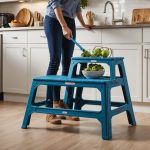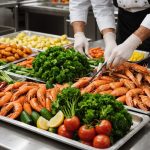Overview of Food Safety Standards
Understanding the pillars of food safety standards is vital for maintaining a safe and compliant commercial kitchen. These regulations are designed to protect public health by ensuring food products are prepared and stored properly. Restaurants must adhere to a variety of commercial kitchen protocols to ensure they operate within the established food hygiene regulations.
Key components of food safety include regular inspections, appropriate food handling practices, and maintaining hygienic environments. Failure to comply with these standards can lead to severe consequences, ranging from health risks to reputational damage and legal liabilities. It is crucial for restaurants to be familiar with guidelines such as the Hazard Analysis Critical Control Point (HACCP) system, which helps identify potential hazards and implement measures to control them.
Also to see : Creating an Ever-Evolving Seasonal Menu: Innovative Ways Restaurants Can Utilize Fresh Ingredients
Businesses must also stay updated with any changes in food safety legislation. Regular staff training and adequate documentation of food safety measures are essential practices. In essence, diligent adherence to these standards not only safeguards public health but also reinforces customer trust and business credibility. By prioritising food safety, restaurants can ensure a secure dining experience for their patrons.
Best Practices for Handling Fresh Produce
Ensuring the safety of fresh produce is crucial in a commercial kitchen setting. Adhering to established vegetable handling tips and produce sanitation methods can significantly reduce the risk of contamination.
Also to see : Mastering the Farm-to-Table Experience: Winning Tactics for Upscale Restaurants
Cleaning and Sanitizing Procedures
One of the initial steps in fresh produce safety is thoroughly washing fruits and vegetables under running water before use. It is essential to sanitize surfaces and tools used in the preparation of produce. Utilize food-safe cleaning agents to disinfect cutting boards and utensils, preventing bacteria from spreading.
Proper Storage Techniques
Storing produce correctly is vital to maintaining its freshness and safety. Refrigerate perishable items promptly and segregate them from raw meats to prevent cross-contamination. Ethylene-producing fruits, such as bananas and apples, should be stored separately from other produce to prolong shelf life.
Techniques for Cutting and Preparing Produce
Utilising safe techniques in the preparation process is another layer of protection. Use separate cutting boards for different food types, and routinely sharpen knives to ensure clean cuts, which minimise bruising and bacterial entry points. Incorporating these practices reinforces hygiene standards and contributes to the overall safety of the cuisine served to patrons.
Comprehensive Safety Tips for Raw Shellfish
Ensuring raw shellfish safety is critical in maintaining healthy kitchen practices. It begins with sourcing quality shellfish.
Sourcing Quality Shellfish
Identifying reputable suppliers is paramount. Choose vendors who adhere strictly to seafood handling practices and possess the necessary certifications. This guarantees that the shellfish is harvested sustainably and is fresh, minimising health risks linked to shellfish consumption.
Safe Handling Techniques
Handle shellfish with care to prevent contamination. Shellfish sanitation involves maintaining a clean working environment and using only sanitised tools. Always wash hands thoroughly before and after handling to avoid cross-contamination. Make sure shellfish are kept at recommended temperatures to maintain freshness and safety.
Display and Storage Practices
Proper storage is vital. Refrigerate shellfish immediately and store them in well-ventilated containers to prevent spoilage. Regularly check storage temperatures and ensure conditions meet shellfish safety standards. Displaying shellfish in a clean environment, separate from other food types, helps preserve quality and protect against bacterial growth. By following these comprehensive safety tips, your kitchen can maintain high standards of hygiene and ensure the seafood is safe to serve to your patrons.
Preventing Cross-Contamination
Cross-contamination is a primary concern in any kitchen, significantly affecting the quality and safety of food. Identifying its sources is the first step in implementing effective measures. Common culprits include contaminated utensils, improperly cleaned surfaces, and improper storage methods. To maintain high food handling safety standards, kitchens must adopt vigilant kitchen hygiene practices.
Strategies for Preventing Cross-Contact
Preventing cross-contact between raw and cooked foods is achievable through practical strategies. Designated cutting boards and utensils for different food groups, such as raw meats and vegetables, are essential. It is critical to clean and sanitize these tools after each use. Additionally, encourage frequent and thorough handwashing among kitchen staff to prevent the transfer of bacteria.
Importance of Separation
Keeping different types of foods separate during storage and preparation is fundamental in preventing cross-contamination. Raw proteins should be stored on lower refrigerator shelves to avoid dripping onto ready-to-eat foods. Label food containers to ensure proper organisation, and maintain consistent temperature checks. By implementing these measures, a kitchen can effectively safeguard against potential health hazards and ensure a secure dining experience for customers.
Training Staff on Food Safety Protocols
In a bustling kitchen environment, continuous staff training is essential to uphold rigorous food safety education. Understanding culinary best practices is not just a requirement but a cornerstone to maintaining a health-conscious kitchen.
Effective training sessions should cover critical topics such as cross-contamination prevention, correct food storage, and equipment sanitisation. Employees must know how to identify spoiled ingredients and recognise potential risks in food preparation. Hands-on demonstrations, rather than theoretical lessons, offer practical insights that staff can use.
Certification programmes, such as Food Safety Level 2, can bolster an employee’s understanding of essential food safety laws and practices. Engaging with these resources not only enhances compliance but promotes a culture of safety within the team. Regular refresher courses and updates on the latest food safety regulations are equally important.
Support and encouragement help create an environment where staff feel empowered to prioritise quality and safety. By consistently providing comprehensive training and education, restaurants can ensure their team is well-prepared to deliver customers a safe and delightful dining experience. This dedication to education underscores the business’s commitment to culinary excellence and public safety.
Monitoring and Compliance with Food Safety Practices
Effective food safety monitoring is essential to ensure that restaurants adhere to necessary standards and regulations. Establishing a routine for compliance checks and kitchen audits helps maintain high safety levels. Regular audits evaluate the kitchen’s adherence to hygiene protocols, identifying any discrepancies promptly.
Recording safety practices reinforces accountability. Implement a robust documentation system to track cleaning schedules, temperature logs, and staff training. This ensures that all aspects of food safety are consistently reviewed and revised as needed.
Utilizing technology can significantly enhance compliance. Digital tools and software offer innovative solutions for monitoring safety procedures, providing real-time alerts and records. For instance, automated temperature monitoring systems reduce manual errors, ensuring foods are stored at the correct temperatures.
Monitoring practices ensure food safety compliance, providing patrons with a secure dining experience. By integrating routine assessments and advanced technology, restaurants can verify their procedures align with established standards, preventing potential risks or infractions.










